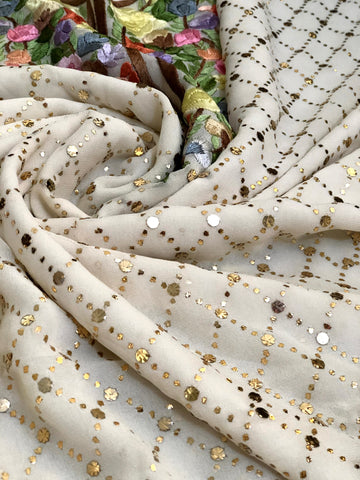Mukaish is a type of embroidery work that is traditionally done in India and Pakistan. It is a form of embellishment that is used to decorate fabrics such as silk and chiffon. The technique involves using a needle and thread to create small, closely-spaced stitches on the fabric, creating a delicate, shimmering effect. The thread used for mukaish work is typically a fine, metallic thread made of gold or silver. It is often used to decorate traditional Indian clothing such as saris and lehengas.

On the other hand, Kamdani is a traditional form of embroidery from Pakistan, specifically from Sindh and Balochistan. It is done on cotton fabric and involves creating intricate patterns using small, closely spaced stitches. The thread used for Kamdani is usually cotton and it is used to create floral and geometric patterns. Kamdani embroidery is typically used to decorate traditional Pakistani clothing such as cholis, dupattas, and ghagras.
In short, Mukaish is a type of embroidery work that is primarily used to decorate silk fabrics while Kamdani is used to decorate cotton fabrics, both have different technique and thread used.
Badla is a type of Indian and Pakistani embroidery work that involves using small, closely spaced metallic stitches to create intricate patterns and designs on fabrics. The thread used for badla work is typically a fine, metallic thread made of gold or silver. It is often used to decorate traditional Indian and Pakistani clothing such as saris, lehengas, and kurtas.
All Mukaish, Badla and Kamdani Embroideries have slight variations but commonly known as same.
Chikankari and Mukaish work
Chikankari and Mukaish work go hand in hand. Generally, Any lehengas, Anarkali dresses and Sarees are done with both the chikankari and mukaish work.

Chikankari and Ring Mukaish work
Process of Mukaish work
The process of Mukaish embroidery typically involves the following steps:
-
Preparing the fabric: The fabric is washed and starched to make it stiff and easy to work on.
-
Transferring the pattern: The desired pattern is traced onto the fabric using a carbon paper or a transfer pencil.
-
Stitching: Using a needle and the metallic thread, small, closely-spaced stitches are made on the fabric following the traced pattern. The stitches are usually made on the back of the fabric, with only small parts of the thread visible on the front.
-
Finishing: Once the stitching is complete, the fabric is washed again to remove the starch and soften it. The thread may be ironed to make it smooth and shiny.

Mukaish embroidery requires a high level of skill and patience, as the stitches are small and closely spaced, and the thread is delicate and easily breakable. It is a time-consuming process and can take several days or even weeks to complete a piece.

